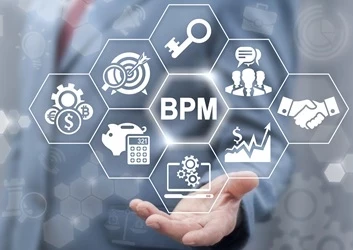Now in its sixth year, BPM Live is our biggest online event - and this year it's beating records for registrants and attendees. Although the event is over, sessions are still available on catchup.
Here's our take on what happened in the sessions.
Peter Evans - LEGO
Inside LEGO's continuous improvement strategy - turning strategy into fast results
Peter brought us up to speed with a few eye-opening statistics about LEGO - including the astounding number of tires the company produces: 700,000,000 every year - making them the biggest tire manufacturers in the world. Peter didn't tell us whether that included the four tires on this Bugatti Chiron - even if the rest of the car was made of over a million LEGO parts and powered by 2,300 LEGO motors.
We got a real sense of Peter's enthusiasm for the brand - in his own words, 'It's the first company I've worked for that made people smile,' and alongside that enthusiasm ran really valuable business lessons. As Peter has said before, LEGO has a very strong corporate culture, 'but you won't find our values written up on the walls, we live them every day.'
With a mission statement that promises to 'inspire and develop the builders of tomorrow,' the spirit of 'only the best is good enough' drives a lot of behavior - which is highly appropriate for OPEX. This drive was enough to instill a desire for improvement in an organization that Peter told us had seen a lot of change - but not necessarily seen great results for the effort. 'We had one hammer and every problem looked like a nail.' Peter's tenure marked an opportunity to start again and rethink things in a different way.
WATCH BACK ON-DEMAND
Dave Marcus, VP Digital Process Automation Strategy – UiPath
Accelerating the future of work
Dave is in an enviable position: UiPath is 'a significantly growing vendor in a significantly growing space,' - with Dave predicting that the business will employ more than 2,000 people by the end of the year. In a recent round of investment, the company was valued at over $3 billion. So what are they offering that's so attractive to investors and customers?
As Dave told us, 'We assist people in real time - there are all sorts of user.' RPA software is about repetitive rule-based tasks such as opening emails, filling in forms, reading and writing to databases, and call center tasks: short-lived, highly predictable processes.
The benefits of RPA depend on where you are on your journey - and what a customer expects from the technology will depend on their level of maturity. RPA is an opportunity to rethink all processes, removing those that don't add value and making the journey from start to finish more efficient.
'If there's one thing we've discovered,' Dave told us, 'it's that people don't naturally gravitate towards [RPA] and understand it. Some people do understand, but the concept in a broader-scale-based way only happens when there is education and creating awareness across the company.'
Dave talked up the process mining tools that make it easier for people to understand what's happening inside their organizations, and the 125,000 people in the UiPath RPA community finding new ways to do things and push the envelope. From centers of excellence to informal communities sharing ideas, best practice, and letting other people be productive with the technology, new uses are being found for the technology every day.
'Demand will likely outstrip our predictions,' said Dave. Why? Because RPA is helping companies make a journey that they need to make - or go obsolete. The rewards? Boosted productivity, fewer errors, higher efficiency, increased customer service satisfaction, and higher job satisfaction.
Dave's other bold prediction for the future is that blockchain will become more important and become something people think about a LOT.
WATCH BACK ON-DEMAND
Malcolm Ross, Appian; Ingolv Urnes, PS Kinetic
Deliver return on automation with BPM
Ingolv's mission is, he says, 'to deliver a return on automation. First looking at healthcare, then GDPR.'
Looking at health economies, Ingolv identified bottlenecks in a messy landscape that were slowing down the process for everyone. But involving computers in healthcare is not without problems, and Ingolv was conscious that 'A critical part of what we do is safe and effective automation... How do we automate? We run industrial-scale RPA to collect referrals. We have a lot of largely unstructured data.'
Ingolv's example of a six-minute referral process performed by humans being cut down to zero by a machine - was compelling evidence for the benefits of automation.
We looked at how the journey had begun with a rule engine and is progressing towards letting algorithms make clinical decisions, with call centers ultimately turning into automation monitoring stations.
Malcolm from Appian platform agreed that technology is always undergoing refinement, and one of the big learnings from the last couple of years has been that we are in a decomposed IT landscape - with far fewer silos than in the past.
The low code approach of Appian enables people to build in more collaborative ways. 'Low code allows people to immediately execute,' said Malcolm, and just as different clients have different needs, there will be different types of AI emerging: 'No one AI to rule them all!'
WATCH BACK ON-DEMAND
Michal Rosik - Minit
Enhance your RoI with process mining
Michal defines Return on Investment as the total investment of profit divided by both visible and invisible costs (which can include insurance, depreciation, replacement of equipment, legal contracts and scalability).
Michal introduced five aspects of BPM that can be used to gain potential benefits: automation, optimization, quality, solution development, and compliance.
Above all, change management needs to be a priority, and senior managers must have full involvement to give accountability.
Michal's firm belief is that we should take inspiration from Nike: Just Do It!
WATCH BACK ON-DEMAND
Nicholas Hymer, Aflac
Concept to Kaizen: BPM at Aflac
Nicholas reviewed Aflac’s history since 2016, boiling the ‘why’ of the business down to: ‘How can we improve customer experience by improving our technology?’
It’s a philosophy that has paid off with rapid expansion: the company now employs 10,000 staff globally – staff whose jobs are augmented by robots: ‘We also have decided to automate the things that are manual and expensive, adding value to customers and in doing that removing barriers to an improved experience.’
Clearly, this is a business that practices what it preaches: ‘Starting small, creating a repeatable and scalable process.’
Nicholas suggested that businesses look at any opportunities to streamline processes that could be completed by a computer faster than a human. This streamlining, he said, led to the development of the Aflac business process solution
It’s a marathon, not a sprint.
Nicholas used his experience as a distance runner as a metaphor for successful implementation, using a similar approach to running a business transformation project as he would to prepare for a race. Nicholas advocated knowing the route, breaking down silos of information, planning rest stops, and selecting the right shoes (or tools for the project). Above all, the message was one of improving the relationships that individuals within an organization have with one another and the information they hold so that each member of the team can be a support to the others no the journey. Collaboration, Nicholas demonstrated, was the key to reaching the finish line.
Watch back on-demand
James Morgan A14 Project and Neil Young at FlowForma
Automation, visibility and enterprise mobility
James joined the A14 project in 2016 and gave us a sense of just how big the project is: 2,500 workers distributed along a 31km route, with the challenges of the project being that construction is traditionally reliant on paperwork, and that cell phone coverage in the area is particularly poor. Nevertheless, the project is on track to complete as agreed in 2020.
So why is this project different?
Reducing the amount of paperwork is a key factor in speeding up and streamlining processes, improving governance, keeping track of deliveries, and quality control. Given the distribution of staff, it was also deemed useful to have cloud-based tools, built on the SharePoint platform, which didn’t require any coding.
On a practical level, getting people up and running on the software was relatively painless, with James estimating that it took about six to eight hours spread over three weeks to get people comfortable with using the technology – a commitment that could work around a regular schedule.
There are a number of processes that have been incorporated into the system, including permission to dig, site visit requests, material requisitions, IT project requests, and recruitment. A further process is added every two to three weeks. James told us that the benefits to the project include faster processes that save days of admin, integrated data for better reporting, better governance with an audit trail, and a single source of truth for all data.
Neil took us through a quick demo, solving key areas in everyday processes and using a variety of different examples from doctors to soccer coaches. He also gave some practical tips about how to approach the automation of processes by starting with the smaller, easier processes and chipping away at them before tackling the bigger ones.
Watch back on-demand
Andy Sutherland and Alex Petrunenko, bpm'online
Four accelerators essential to your digital transformation
This session opened with some startling indicators that the world is accelerating through digital transformation and data. This has been held responsible for the surprising fact that pedestrians have been measured as walking 10% faster than they were 10 years ago, and that it took Pokemon just 19 days to achieve the same number of customers as the first 50 years of the entire airline INDUSTRY.
In other statistics, 72% of fortune 500 companies feel the greatest challenge limiting their growth is technology, and that business software is NOT meeting expectations.
BPM'online Studio is a low-code platform that enables businesses to use BPM, and in this session we looked at a real-world example of how it has been put to good use.
Evraz's problem was that their HR group was distributed across a wide area, yet had to deal with people in a central office. Manual process meant that it was difficult to support users – and the result was a lot of frustration on both ends. HR was spending 30 per cent of time on strategic goals and 55 per cent on interactions with users, trying to service them properly. BPM reduced errors, increased happiness and satisfaction, and improved transparency.
Watch back on-demand
Andrew Murphy, VP, EMEA, K2
BPM Or RPA: What is the correct choice for digital transformation
The cost of getting something wrong, Andrew told us, can be high: a decimal point here, an extra zero there could literally be a matter of life and death in some situations. So it's a very positive development that tasks are being given to computers that can complete them with greater accuracy and fewer errors.
Computer decisions are also easier to audit on a screen rather than delving into the 'he said, she said' of human conversations.
Andrew looked at the differences between BPM and RPA, concluding that
- RPA gives you time to innovate. It automates currently existing systems, giving business owners space to actually do something better.
- BPM empowers people. They don’t have to go and do mundane tasks; people can build their own applications, take charge and do things better; and it gives leadership an understanding of where to innovate.
Andrew also examined the customer's role in driving change with expectations pushing boundaries - for example, we've gone from going into the bank to ask for a loan to phoning up and asking someone in a contact center. Now we’re talking to a chatbot on a WhatsApp-type platform.
By 2020, according to Andrew, 60 per cent of app development will be done outside traditional IT teams. Citizen developers will be able to do create new products under their own steam.
Watch back on-demand
Anthony Deighton, CMO, Celonis
Siemens’ fast lane to RPA success with Celonis
How is the industry shifting and changing? Anthony told us that there are two economic drivers:
1. Customer expectations: today we regard it as frustrating to wait for a buffering film on Netflix - though it's certainly less time-consuming than going to the video store (if you can still find one).
2. Changes in how we can drive productivity: the old tricks to drive productivity no longer work – you can’t, for example, outsource your problems to low-cost labor anymore.
As Anthony noted, only 12 per cent of fortune 500 companies from 1955 are still here today. There is a strong change imperative, but change itself is hard when your organization works in silos. The good news? Most processes that cut across silos and systems are able to provide real value.
Process mining technology looks at digital footprints in the underlying digital system, enabling users to watch how data flows through systems and interacts with users. From that, users are able to derive the underlying business process that created that data, and understand things better – once understood, it can be changed.
The headline figure Anthony gave the webinar was that process mining had helped to streamline Siemens's order-to-cash process, and thereby eliminated $125 million of costs annually.
At the end of our final session Sally Fletcher wrapped up the conference with some of the big learning moments from across the series.




















